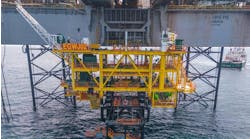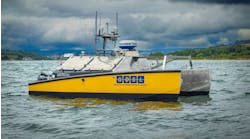Jennifer Pallanich Hull
Pioneer soaring with Harrier find
Pioneer Natural Resources made another find near its operated Falcon field in the deepwater Gulf of Mexico. Located in East Breaks block 759 in 3,600 ft of water, the Harrier discovery well was drilled to 9,510 ft measured depth. Drilled by the Noble Homer Ferrington, the well encountered over 350 ft of gas-bearing sand in a single zone. Pioneer operates the East Breaks block 759 with a 75% working interest, and Mariner Energy holds 25%. Harrier marks Pioneer's second operated deepwater discovery, following neighboring Falcon in East Breaks block 579.
The US independent said it plans to develop the field as a single-well subsea tie-back to its Falcon field with first production in nine to 15 months. The pipeline connecting the Falcon field to the Falcon Nest platform on the Gulf of Mexico shelf has the working capacity to handle 175-200 MMcf/d of gas and is due onstream in 2Q 2003. Pioneer said it expects the Harrier discovery to significantly extend the utilization of the Falcon facilities.
Harrier was Pioneer's third well in a three-well series. Susan Spratlan of Pioneer's investor relations department said the company plans to use information gained from the Lightening and H2.5 dry holes as well as data from the Harrier find to reprocess its prospects.
In other Pioneer news, the company and Wood-side Energy (USA) Inc., a subsidiary of Woodside Energy Ltd. of Australia, have agreed to a two-year joint exploration over the shallow-water Texas shelf region of the Gulf. Under the agreement, Woodside now has a 50% interest in 47 Pioneer-operated offshore exploration blocks. The agreement covers eight prospects and 19 leads and includes five wells in 2003 and three in 2004. Most of the wells will target gas plays below 15,000 ft.
Woodside Director of New Ventures Agu Kantsler said the agreement will enable the company to cost-effectively participate in and evaluate the GoM shelf gas play.
Kantsler said the acreage targets emerging deep gas, an under-explored play that has attracted significant interest in the past few years, primarily because discoveries can be brought into production within six months to two years due to their proximity to existing infrastructure.
"This opportunity offers the potential for Woodside to achieve gas production and revenue from the Gulf shelf within the next two years," Kantsler said.
Goose shows for Spinnaker
Spinnaker Exploration Co.'s Goose prospect at Mississippi Canyon block 751 found oil and natural gas. Located in 1,600 ft of water, the Mississippi Canyon block 751 No. 1 well was drilled to 14,288 ft TD, at a down-dip position in the accumulation. The company confirmed 110 ft gross of hydrocarbon pay.
No water contact was encountered in the well bore, and reservoir quality is excellent, Spinnaker said. An up-dip sidetrack of the Mississippi Canyon block 751 No. 1 well was conducted to test continuity in the reservoir. A second objective on the block could be accessed from the Mississippi Canyon block 751 No. 1 surface location.
Pre-drill reserve estimates for Mississippi Canyon block 751 were 10-20 MMboe. Operator Spinnaker holds 100% working interest.
Discoveries to go onstream in 2Q 2003
Magnum Hunter Resources and partner Remington Oil and Gas made two recent discoveries in the Gulf of Mexico, Magnum Hunter said.
The West Cameron block 416 No. 1 discovery well encountered a single gas sand with 60 ft of net pay. The well tested at production rates of 14 MMcf/d of oil equivalent and will be tied back to the partners' existing West Cameron block 417 production facility, which was brought onstream in June 2002. Magnum Hunter estimates that the combined initial rates of these new discoveries should reach 30 MMcf/d of equivalent. First production is anticipated in 2Q 2003. Operator Remington holds 50%, and Wiser Oil Co. and Magnum Hunter each own a 25% working interest.
The South Marsh Island block 24 No. 2 discovery is being completed in a single sand with 52 ft of net pay in an interval above 16,970 ft. This deep shelf discovery qualifies for royalty relief with the Minerals Management Service on the first 20 bcf of natural gas produced. First production is anticipated in 2Q 2003.
Magnum Hunter owns a 30% working interest, and operator Remington holds the remaining interest.
"With drilling rig and service costs at unusually low levels in relation to current commodity prices, the Gulf of Mexico will capture $60 million, or 60%, of our company's 2003 capital budget. Four deep shelf projects are included in this budget," Magnum Hunter Senior Vice President of Exploration Charles R. (Chuck) Erwin said.
Oil seepage exceeds platform releases
According to the "Oil in the Sea III" report released last year by the National Academy of Sciences, far more oil enters the ocean from natural, underwater seeps than from offshore production platforms. While difficult to believe, over the past 20 years, less than 0.001% of the oil produced in US state and federal waters has been spilled, said Minerals Management Director Johnnie Burton. The seeps from the earth's strata introduce about 1,700 b/d of oil into US marine waters, which is about 150 times the amount from oil and gas activities, she said earlier this year.
Worldwide, the vast majority of incidents in which petroleum has entered the ocean are caused by natural seeps, marine transportation, industrial and municipal wastes, and runoff, she noted. According to the study, leaks from platforms in federal waters have decreased significantly over the past 29 years.
A key recommendation from a previous NAS study was cooperation of federal and state agencies to promote cleaner extraction techniques, enforce regulatory standards, and examine the condition of aging pipelines to minimize releases of oil in the ocean. All of these have been and are being done, Burton said.




